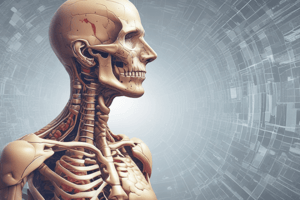Podcast
Questions and Answers
What is barium sulfate used for in GI imaging?
What is barium sulfate used for in GI imaging?
- To displace the intraluminal contrast
- To visualize soft tissue density
- To study the intraluminal anatomy (correct)
- To form a muscular tube
What does a double-contrast GI imaging procedure involve?
What does a double-contrast GI imaging procedure involve?
- Using both thicker barium and air (correct)
- Using a single type of contrast agent
- Using only barium as the contrast agent
- Using air as the only contrast agent
What is the preferred technique for better visualization of the mucosa in GI imaging?
What is the preferred technique for better visualization of the mucosa in GI imaging?
- Using thicker barium as the contrast agent
- Using only air as the contrast agent
- Single-contrast technique
- Double-contrast technique (correct)
Where does the esophagus extend from and to?
Where does the esophagus extend from and to?
What is the normal location of air or contrast within the lumen of the esophagus?
What is the normal location of air or contrast within the lumen of the esophagus?
Flashcards are hidden until you start studying
Study Notes
Barium Sulfate in GI Imaging
- Barium sulfate is used as a radiopaque agent to enhance the visibility of the gastrointestinal tract during imaging procedures.
- It coats the lining of the GI tract, allowing for better contrast on X-ray images.
Double-Contrast GI Imaging Procedure
- Involves the use of both barium sulfate and gas (usually carbon dioxide) to create a clearer image of the mucosal surface.
- Provides detailed visualization of lesions, polyps, and abnormalities in the GI tract.
Preferred Technique for Mucosal Visualization
- The double-contrast technique is favored for superior visualization of the mucosa, facilitating the detection of small lesions and changes in the lining.
Esophagus Extension
- The esophagus extends from the pharynx to the stomach, specifically from the cricoid cartilage at the level of C6 to the gastroesophageal junction at T11.
Normal Location of Air or Contrast in the Esophagus
- Usually, air or contrast should be present in the lumen of the esophagus, appearing as a radiolucent area on imaging studies.
- The presence of air indicates a properly functioning esophagus, while any obstruction may lead to an abnormal accumulation of contrast or lack of air.
Studying That Suits You
Use AI to generate personalized quizzes and flashcards to suit your learning preferences.




